Lamps do more than light up your home. They add beauty and function, making your space look great. A cozy bedside lamp can make your room feel warm and inviting. A bold floor lamp can be the centerpiece of your living room.
This guide will show you how lamps can change your home’s look. We’ll talk about how to use them to get the right lighting and style. Whether you want a cozy feel or a bold look, lamps can help.
Let’s explore how lamps can make your home look better. We’ll find the perfect mix of beauty and usefulness.
Understanding Lamps as Decorative Elements
Lamps are more than just lights; they are key parts of your home’s look. They add architectural details, visual appeal, and a personal touch. Lamps can change how a room looks by making it more stylish and cozy.
The Dual Role of Lamps in Home Design
Lamps have a dual role in home design. They light up spaces and also add to the decor. The design, from base to shade, greatly affects a room’s look. Choosing the right lamps can make your home look better and more unified.
How Lamps Transform Living Spaces
Lamps can change a room’s feel. The style, size, and where you put them can set the mood and highlight a room’s best features. Whether it’s a big floor lamp, a small table lamp, or a pendant light, lamps can show a room’s personality.
Aesthetic Value Beyond Illumination
Lamps are more than just lights. They are decorative pieces that bring interest and character to a room. From old-style lamps to modern ones, lamps can be both useful and stylish, improving your home’s design.
“Lamps are the jewelry of a room, adding the finishing touch that can make or break the overall look and feel.”
decorating with lamps
Decorating with lamps can significantly enhance the atmosphere of any space, merging functionality with aesthetics in a seamless way. Understanding how to incorporate lighting effectively is crucial for achieving the desired mood in your home. Whether you’re opting for floor lamps, table lamps, or even wall sconces, each type can play a pivotal role in the overall design scheme. When selecting lamps, consider not only their illumination capabilities but also how they complement other elements in the room. The right lamp can serve as a focal point, drawing attention and adding character to an otherwise bland corner.
Many people debate whether a lamp qualifies as furniture. While a traditional sense of furniture conjures images of couches and tables, at home lamps can arguably hold a similar significance. They provide structure to a space, define areas, and contribute to the overall style of a room just like furniture pieces do. By choosing stylish lamps, you can enhance the decor while also ensuring there’s adequate lighting for activities such as reading, socializing, or simply relaxing at home. It’s essential to think of them not only as sources of light but as integral elements that can unify a room’s design.
When decorating with lamps, consider the different styles, colors, and sizes available. A large, dramatic floor lamp can create a cozy reading nook, while delicate table lamps can add sophistication to side tables in a living room or bedroom. Mixing and matching various lamp styles can create an eclectic yet harmonious look, while sticking to a cohesive design can emphasize a more streamlined aesthetic. Additionally, strategically placing lamps in different parts of your home can drastically change the ambiance and bring warmth to spaces that might otherwise feel cold or uninviting.
Lastly, don’t forget about the practical aspects of decorating with lamps. Think about the purpose of each lamp—is it meant to provide bright, focused light for work, or soft ambient lighting for relaxation? Be mindful of the bulb types and their brightness levels, as this can impact not only the utility of the lamps but also the overall vibe of the room. By thoughtfully selecting and arranging at home lamps, you can create a beautifully illuminated environment that caters to your lifestyle while making a bold decorative statement.
Is A Lamp A Decoration: Exploring the Design Perspective
Lamps are seen as part of furniture because they add beauty and function to a room. Lamps bring style, set the mood, and act as decorative lighting fixtures. Their design, from base to shade, greatly affects a room’s look and fits well with other design pieces.
Design history, like Art Nouveau and Mid-Century Modern, shapes how we see lamps today. For example, the Bauhaus movement made lamps simple, functional, and industrial.
New tech has changed lamp design and how we see them. Now, we have eco-friendly, stylish lamps with LED lights. Tools like Studio Flash Light help designers play with design, colors, and shapes. This makes it easier to share ideas and learn from each other.
“Lamps are not just a source of illumination; they are design elements that can transform the entire ambiance of a space.”
In summary, lamps are more than just lights; they’re key parts of furniture and design. Knowing how lamps fit into design helps both homeowners and designers create beautiful spaces.
Types of Decorative Lighting for Your Home
Lighting is key in home decor. It sets the mood, enhances ambiance, and shows off your living spaces. There are many types, like ambient, task, and accent lighting. Each type has its own role in your home’s design.
Ambient Lighting Options
Ambient lighting lights up the whole room, making it warm and inviting. Pendant lights, chandeliers, and floor lamps are great for this. They light up the room and add to your home’s look.
Task Lighting Solutions
Task lighting is for specific tasks, like reading or cooking. Table lamps, wall sconces, and under-cabinet lighting are good for this. They give you the light you need for these tasks.
Accent Lighting Choices
Accent lighting highlights special features or artwork. Recessed lighting, track lighting, and spotlights are good for this. They make your home’s design stand out.
Using a mix of ambient, task, and accent lighting makes your home look and feel great. It meets both your needs for function and style.
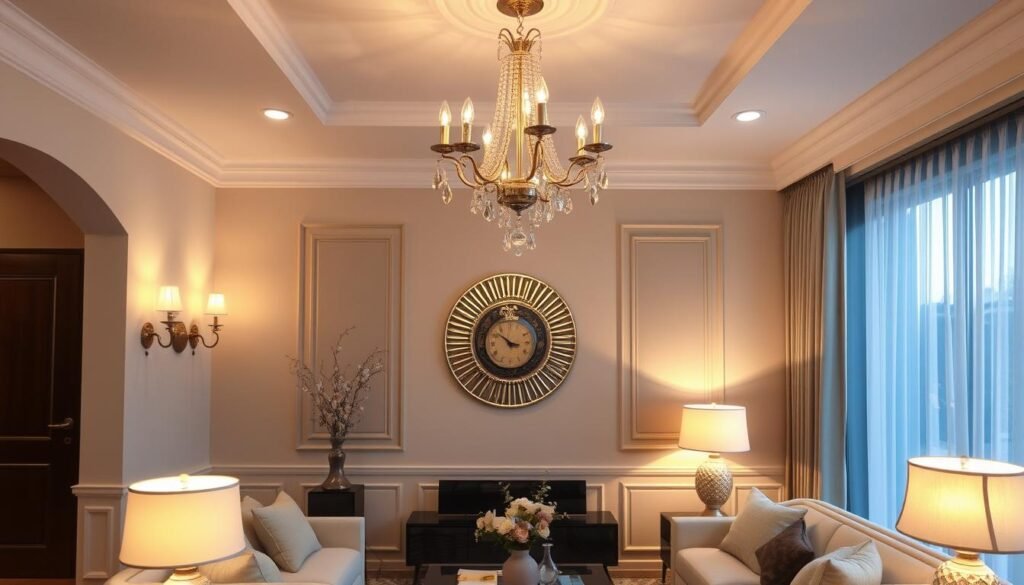
“Lighting has the ability to make or break a space. It can transform a room from dull and uninviting to warm, cozy, and welcoming.”
Strategic Lamp Placement in Different Rooms
Proper lamp placement is key for balanced lighting in your home. By placing lamps wisely, you improve both function and beauty in each room. This helps create a unified design.
In the living room, lamps on end tables or sofas add warmth. Bedrooms need soft bedside lamps for a cozy feel. Dining rooms might have lamps on consoles or buffets to light up the area.
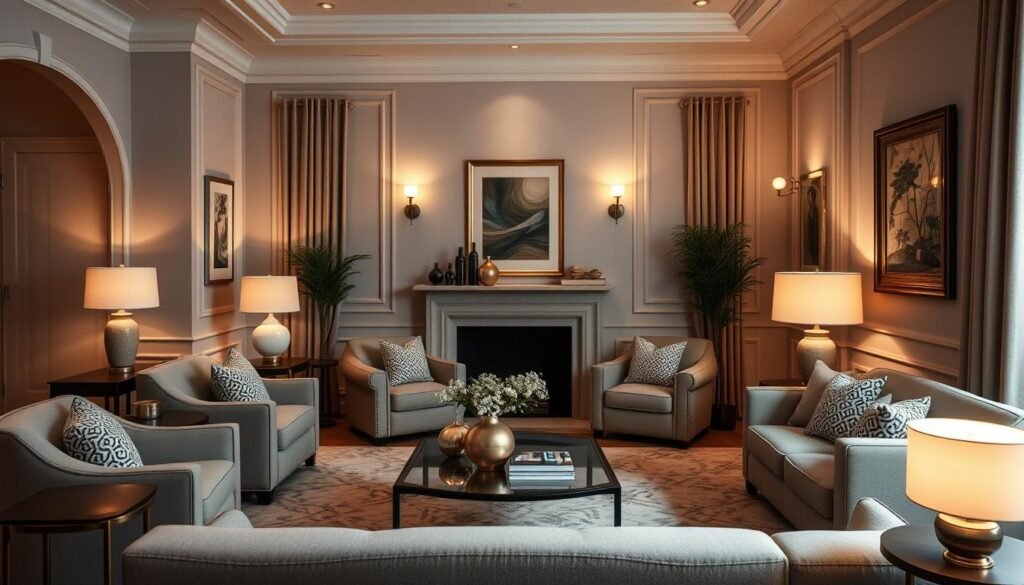
For room lighting design, aim for three light sources, not counting daylight. This mix of floor, table, and overhead lights makes a space cozy and bright.
For best task lighting, put table lamps 3-5 feet from seats. The lampshade should be at eye level when sitting, about 40-45 inches off the floor. Think outside the box with lamp placement ideas. Try lamps on shelves, behind furniture, or on the floor for a unique look.
“Strategic lamp placement can transform a room, adding both function and aesthetic appeal to your living spaces.”
By thinking about lamp placement in your home, you can make every room bright and welcoming. This boosts the design and feel of each space.
Choosing the Right Lamp Style for Your Decor
Finding the perfect lamp is key to matching your home decor. Whether you love modern designs or traditional charm, the right lamp can change your space’s look. Let’s look at different lamp styles and how they can improve your decor.
Modern and Contemporary Designs
Modern and contemporary lamps are perfect for sleek, minimalist tastes. They have clean lines, geometric shapes, and focus on function. These lamps fit well in modern or industrial spaces, adding elegance.
Traditional and Classic Options
Traditional and classic lamps are great for a timeless look. They have detailed bases, decorative elements, and classic shapes. These lamps work well with traditional or vintage decor, adding charm.
Transitional Style Selections
Transitional lamps mix old and new, blending traditional and modern. They create a balanced look that fits many decor styles. These lamps add interest and versatility, making them a smart choice.
When picking a lamp, think about your space’s overall look. Match the lamp’s design, materials, and finishes with your furniture and accessories. The right lamp can make your home look better and feel more welcoming.
“Lamps are not just sources of illumination, but also decorative elements that can transform the entire character of a room.” – Connie Vernich, Vernich Interiors
The Impact of Lampshades on Room Aesthetics
Lampshades are key in setting the mood and look of any room. They do more than just light up the space; they can change its whole feel. Whether you choose a classic white shade or something bold and colorful, it can make a big difference.
The shape, size, and material of a lampshade greatly affect the room’s look. For example, black lampshades can make a room feel more dramatic and elegant. On the other hand, colored or patterned shades can bring a lively and personal touch. Even painting your lampshades can give your room a fresh new look.
Designers often suggest fabric lampshades for their soft, even light. This creates a warm and welcoming atmosphere. Paper shades offer a sleek, modern look, while glass and metal shades add a touch of sophistication or a retro vibe.
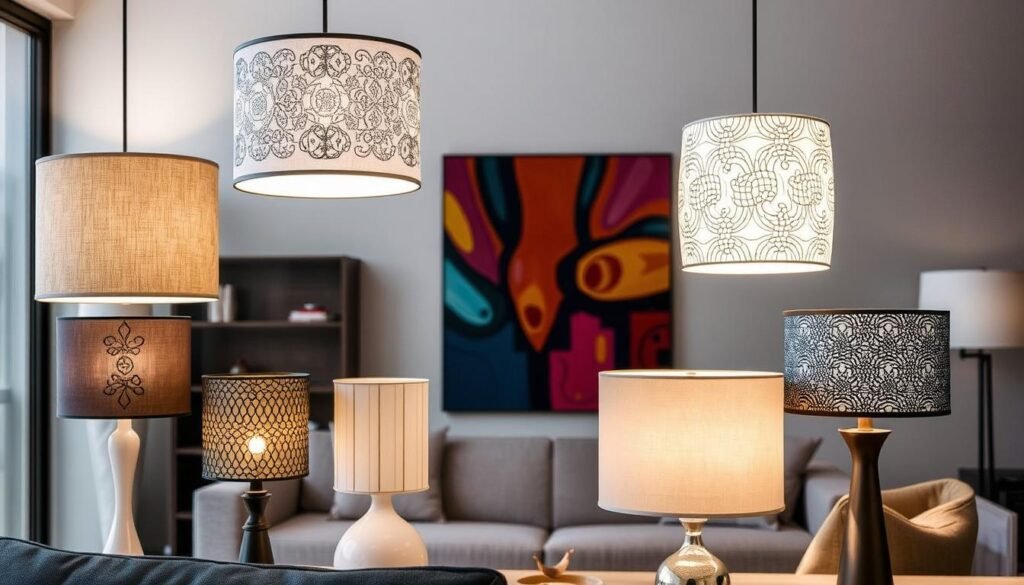
When picking a lampshade, think about its size and proportion. The shade should be about 2 inches wider than the lamp base. For table lamps, the shade should be 60-70% of the lamp’s height. Floor lamps need a shade that’s 30-40% of the lamp’s height.
Choosing the right lampshade design can greatly improve your room’s look. It helps create a space that reflects your style and preferences.
Size and Proportion Guidelines for Decorative Lamps
Choosing the right decorative lamps is key for your home’s look. The size and proportion of lamps are vital for a harmonious space. Here are some important tips for picking the perfect lamp for your rooms.
Height Considerations
The height of a lamp is very important. A good rule is for the lamp to be no taller than 1.5 times the surface it sits on. For instance, a table lamp should be about one-third the height of the table.
The bottom of the lamp shade should be at eye level in the living room or chin level in the bedroom.
Scale and Balance Tips
Getting the scale and balance right is essential. The lamp shade should be smaller than the table or surface it’s on. The shade length should be 65 to 90 percent of the lamp base length for a nice look.
Desk lamps should have a shade that’s about 90% of the lamp base height.
Room Size Relationships
The room’s size affects the lamp size needed. Big rooms can handle taller or bigger lamps. But, small spaces need smaller lamps to keep things balanced.
For living rooms, the ideal table lamp size is 24 to 34 inches. In bedrooms, it’s best to choose lamps between 24 and 27 inches.
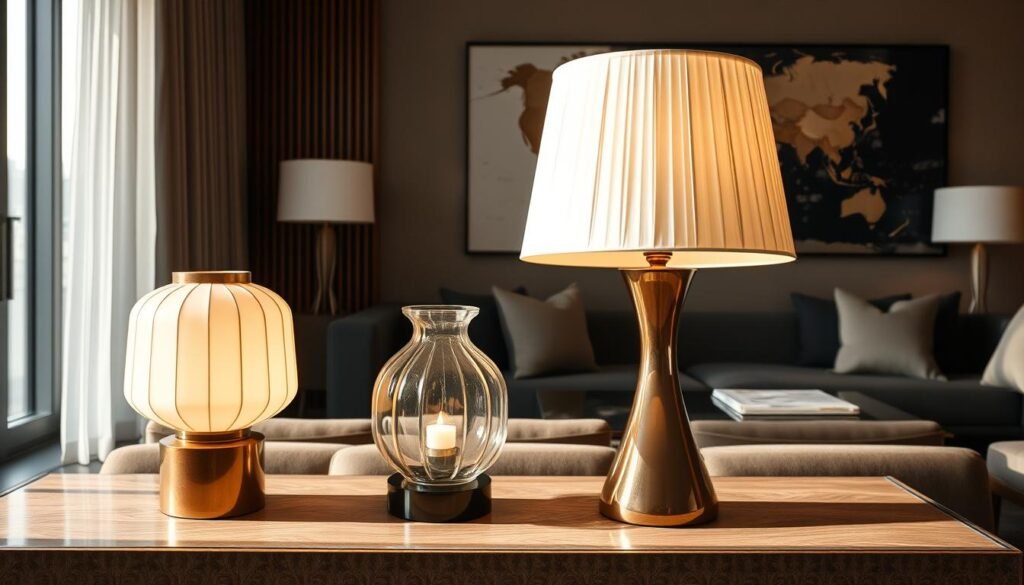
By following these guidelines, your decorative lamps will improve your space’s look. Remember, your personal style and preferences are also important in choosing lamps.
Mixing and Matching Lamps in Your Design Scheme
Decorating your home is like creating a work of art. Mixing and matching lamps can give your space a unique, eclectic vibe. While matching lamps on nightstands or a buffet can look balanced, different styles in a living room can make it more interesting and personal.
To mix lamps well, find common ground like materials, colors, or style. For example, a modern table lamp and a traditional floor lamp can look great together if they share similar tones or finishes.
When it comes to eclectic lamp design, layering different lights is key. This adds depth and lets you adjust the lighting for different activities and moods. Coordinating lamps across your home can also keep it looking unified.
“Mixing and matching lamps is a great way to infuse your personal style into your home decor. It’s all about finding the right balance between unity and variety.”
- Begin with a standout lamp, like a unique floor lamp or table lamp, and add more around it.
- Try different lamp finishes, like brass, copper, or brushed nickel, to add interest.
- Use lamps of varying heights and shapes to create a lively, layered look.
- Feel free to mix old and new lamps for a truly eclectic look.

The secret to mixing lamps is finding a balance between unity and uniqueness. By coordinating design elements, you can craft a lighting scheme that shows off your personal style.
Color Temperature and Mood Creation
The color temperature of lighting greatly affects the mood and feel of a space. Warm lighting, with lower temperatures, makes a room cozy and inviting. On the other hand, cool lighting, with higher temperatures, energizes and stimulates a room.
Warm vs. Cool Lighting Effects
Warm lighting, between 2700-3000 Kelvin, is perfect for bedrooms. It helps you relax and sleep better. Restaurants use warm lighting, like candlelight, to create a romantic feel.
Cool lighting, from 5000 to 6500 Kelvin, is great for kitchens and art galleries. It improves visibility and brings out the colors of artworks.
Creating Ambiance Through Light
The type of light bulbs you choose greatly changes how a room feels. Dimmers and multi-way lamps let you adjust the lighting color temperature easily. This way, you can change the mood lighting in your home to match your mood and activities.
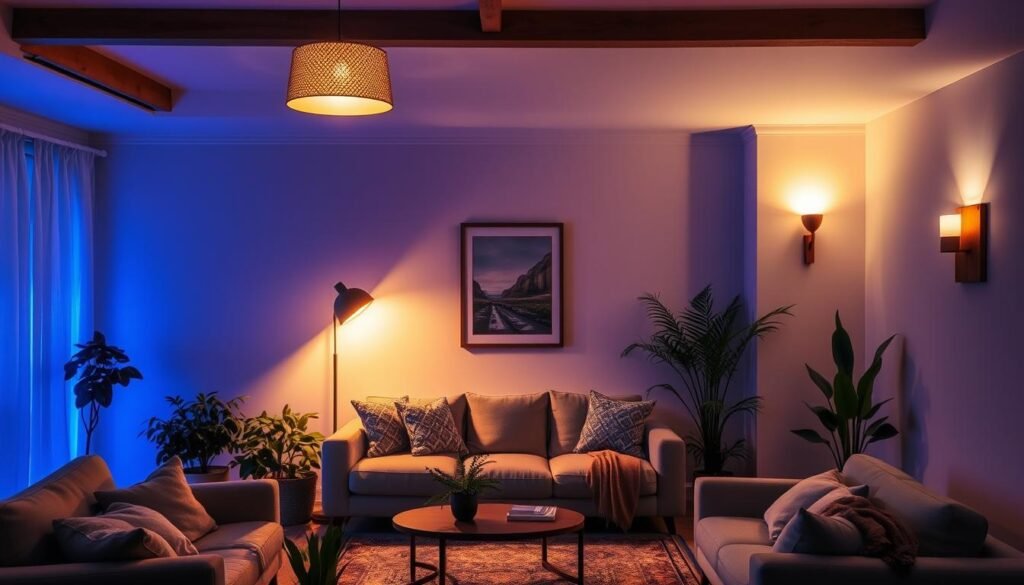
“The right lighting can transform a room, setting the tone and creating the perfect ambiance for any occasion.”
Creative Ways to Update Old Lamps
Updating old lamps can give your decor a fresh look without spending a lot. You can add a new touch to an old lamp or turn a thrift store find into something special. There are many creative ways to make your lamps look new again.
One great idea is to paint the lamp base. Use high-quality chalk-style paints like Annie Sloan’s French Linen for a vintage look. Start with a diluted paint wash, then use a lighter shade like Old Ochre to add depth.
- Use about 2 teaspoons of paint per coat and mix with an equal amount of water for the perfect wash consistency.
- Opt for a foam brush for smooth, even application of the wash.
- Lightly dry brush the base with a complementary color for a subtle, layered effect.
You can also update the shade of your lamp. Thrifted and vintage shades offer many options, from classic silks to rustic rattan. You can mix and match shades for a unique look or choose a simple palette.
“10% of repurposed vintage lamps can be turned into planters, bird feeders, or candle holders.”
Think outside the box and repurpose the lamp base. Old bases can become vases, bookends, holiday decor, or even side tables. With creativity, your old lamps can become special, one-of-a-kind pieces that show off your style.
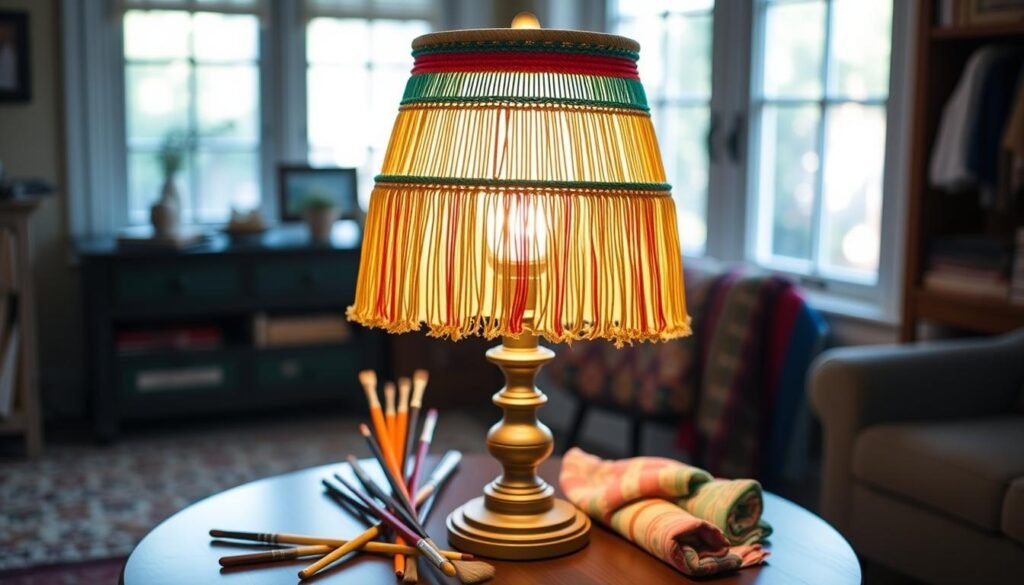
Whether it’s a family heirloom or a thrift store find, updating lamps is a budget-friendly way to refresh your home. With simple techniques and a bit of imagination, you can turn old lamps into unique, personalized pieces that stand out.
Budget-Friendly Lamp Decoration Ideas
There are countless ways to decorate lamps on a budget. You can make your living space look great with DIY lighting projects and upcycling tips. These ideas fit any budget.
DIY Lamp Makeover Projects
Give old or cheap lamps a new look with simple DIY makeovers. Spray painting the base, covering the lampshade with fabric, or adding decorative embellishments can make a big difference. These methods let you add your personal touch to your home’s lighting.
Thrifting and Upcycling Tips
- Search thrift stores, flea markets, and online for affordable lamp decor to upcycle.
- Find vintage or secondhand lamps that can be made over. Try painting, new shades, or repurposing parts.
- Get creative with DIY lighting projects to make unique lamps that show off your style.
Using budget-friendly ideas, you can make your lighting look amazing and personal. Turn ordinary lamps into stunning highlights in your home. It’s fun and rewarding to do it yourself.
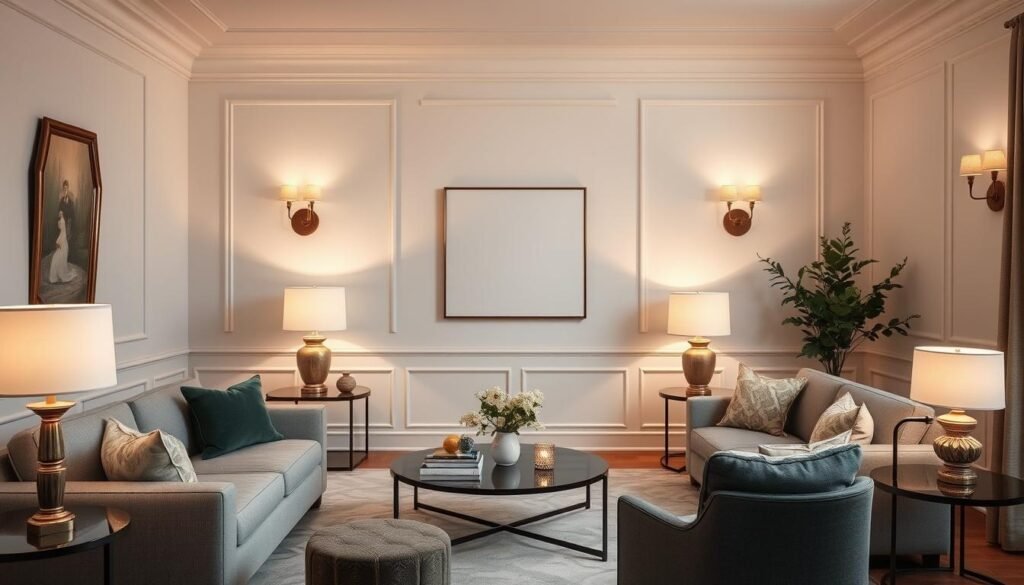
Conclusion
Lamps are more than just lights; they are key parts of home decor. They can make a big difference in how a room looks and feels. By choosing the right lamps, you can make your home cozy and beautiful.
Choosing the right lamps can change a room’s look. You can pick from modern, traditional, or eclectic styles. Lamps are also great for adding character and making a room stand out.
Lamps are very flexible and can be changed easily. They fit well with many design styles. By picking the right size and quality, lamps can make your home look and feel better.
Lamps are important in design and should not be ignored. They can make your home look amazing. By using lamps wisely, you can make your home beautiful and functional.
FAQ
What is the dual role of lamps in home design?
Lamps are both useful and decorative in home design. They provide light and add beauty to a space. They bring warmth, color, shape, and texture.
How do lamps transform living spaces?
Lamps change living spaces by adding beauty and focus. They make a room feel cozy and inviting. They are like “jewelry for the space,” adding style beyond just light.
Are lamps considered part of the furniture category?
Yes, lamps are seen as part of furniture in design. They add style and create a cozy feel. They are decorative objects that light up a space.
What are the different types of decorative lighting?
Decorative lighting includes ambient, task, and accent lighting. Ambient lighting lights up a room. Task lighting helps with specific tasks. Accent lighting highlights special features or objects.
How should lamps be placed strategically in different rooms?
Placing lamps right is key for good lighting in rooms. In living rooms, they go on end tables or sofa tables. Bedrooms need bedside lamps. Dining rooms might have lamps on console tables.
How do I choose the right lamp style to complement my existing decor?
Choose a lamp style that fits your space’s look. Modern lamps have clean lines, while traditional ones have ornate details. Transitional styles mix both.
How do lampshades influence room aesthetics and light quality?
Lampshades change how a room looks and feels. They come in many shapes and materials. White shades let more light through, while colored ones add style.
What are the size and proportion considerations when selecting decorative lamps?
Size and proportion matter when picking lamps. Make sure they’re not too tall or short. Match the lamp’s size to the furniture and room size.
How can I mix and match lamps to create an eclectic design scheme?
Mixing lamps can make a space unique. Use different styles in a room for interest. Match lamps through materials, colors, or design to keep decor cohesive.
How does color temperature affect the mood and ambiance of a space?
Color temperature affects a room’s feel. Warm lighting is cozy, while cool lighting is energizing. The right bulbs can change a room’s mood.
What are some creative ways to update old lamps?
Old lamps can get a new look without spending much. Try painting the base, swapping shades, or adding trim. These DIY projects can make old lamps special.
What are some budget-friendly lamp decoration ideas?
Decorating lamps on a budget is easy. DIY makeovers or thrift store finds can work wonders. Spray painting or adding embellishments can transform cheap lamps. Thrift stores and online marketplaces have great deals.
